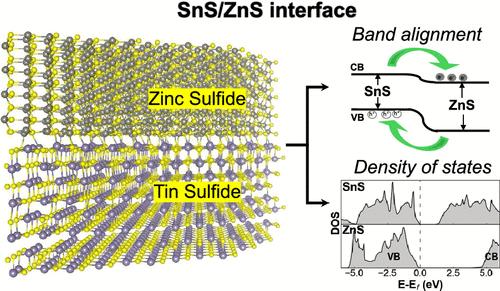SnS/ZnS界面的稳定性和电子性质:第一性原理研究
IF 3.2
3区 化学
Q2 CHEMISTRY, PHYSICAL
引用次数: 0
摘要
在本研究中,我们利用第一性原理计算和高通量界面结构搜索方法研究了硫化锡(SnS)和硫化锌(ZnS)之间的体结构、表面结构和界面结构的稳定性和电子性质。我们的分析揭示了这些材料在电子结构上的显著差异,在体积和表面构型以及原始界面上,观察到SnS和ZnS具有明显的带隙。原始的SnS/ZnS界面呈现交错(ii型)带对准,这有利于太阳能电池的应用。我们进一步探讨了界面缺陷的影响,发现来自SnS和ZnS表面的原子在界面上的均匀分布提供了最佳的稳定性并保持了半导体性能。相反,任何单一元素过量的界面往往表现出金属特征。这些发现强调了原子组成在设计稳定高效的SnS/ZnS界面中的关键作用,为提高薄膜太阳能电池的性能铺平了道路。本文章由计算机程序翻译,如有差异,请以英文原文为准。

Stability and Electronic Properties of SnS/ZnS Interfaces: A First-Principles Investigation
In this study, we investigate the stability and electronic properties of bulk, surface, and interface structures between tin sulfide (SnS) and zinc sulfide (ZnS) by using first-principles calculations and high-throughput interface structure search methods. Our analysis reveals significant differences in the electronic structures of these materials, with distinct bandgaps observed for SnS and ZnS in bulk and surface configurations as well as at their pristine interface. The pristine SnS/ZnS interface exhibits a staggered (type-II) band alignment, which is favorable for solar cell applications. We further explore the impact of interface defects, finding that an equal distribution of atoms from both SnS and ZnS surfaces at the interface offers optimal stability and maintains semiconducting properties. In contrast, interfaces with an excess of any single element tend to exhibit metallic characteristics. These findings highlight the critical role of atomic composition in the design of stable and efficient SnS/ZnS interfaces, paving the way for improved thin-film solar cell performance.
求助全文
通过发布文献求助,成功后即可免费获取论文全文。
去求助
来源期刊

The Journal of Physical Chemistry C
化学-材料科学:综合
CiteScore
6.50
自引率
8.10%
发文量
2047
审稿时长
1.8 months
期刊介绍:
The Journal of Physical Chemistry A/B/C is devoted to reporting new and original experimental and theoretical basic research of interest to physical chemists, biophysical chemists, and chemical physicists.
 求助内容:
求助内容: 应助结果提醒方式:
应助结果提醒方式:


